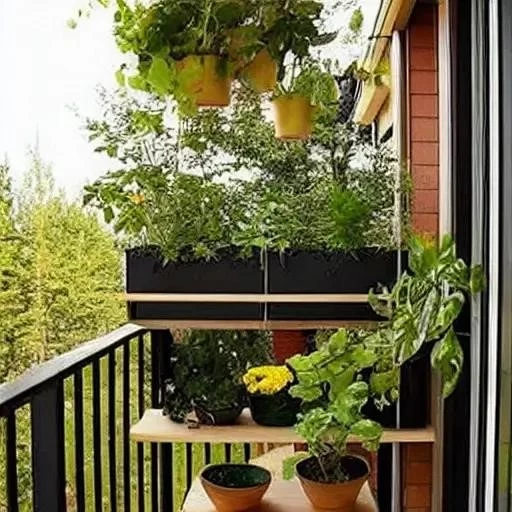
The urban jungle, once defined by towering skyscrapers and bustling streets, is rapidly transforming into a verdant tapestry, thanks to the soaring popularity of container gardening. This innovative approach to cultivation, empowering city dwellers and small-space homeowners to cultivate lush landscapes on patios, balconies, and even windowsills, has become a beacon of green living. However, the dream of a thriving miniature Eden often faces a formidable foe: the unwelcome spectacle of a beloved plant-filled pot toppling over, its contents scattered by an unexpected gust or an accidental nudge. This frustrating setback, a common lament among both novice and seasoned gardeners, can quickly dampen the enthusiasm for this otherwise incredibly rewarding pursuit.
Yet, despair not, for the era of precarious planters is drawing to a close. By integrating insights from horticultural experts and leveraging ingenious design principles, cultivating a stable, resilient container garden is not only achievable but remarkably straightforward. Imagine a vibrant array of blossoming flowers or bountiful vegetables, standing tall and proud, impervious to environmental challenges, consistently enriching your outdoor living space. This article will meticulously explore the foundational strategies and clever hacks that ensure your cherished containers remain firmly grounded, transforming potential gardening woes into triumphs of stability and aesthetic appeal.
Key Strategies for Unshakeable Container Gardens
| Category | Recommended Action | Benefit |
|---|---|---|
| Pot Material & Weight | Opt for heavy materials like terracotta, ceramic, stone, or concrete. | Significantly increases base stability and resistance to wind. |
| Internal Ballast | Place large rocks, bricks, or gravel in the bottom of lighter pots before adding soil; | Adds crucial weight to the base, lowering the center of gravity. |
| Pot Shape & Size | Choose pots that are wider than they are tall, or have straight sides. Use larger containers overall. | Provides a broader, more stable footprint and greater volume for root growth. |
| Plant Selection & Balance | Match plant size to pot size; avoid top-heavy plants in small or narrow containers. | Ensures the plant’s growth doesn’t disproportionately shift the center of gravity. |
| Strategic Placement | Position pots in sheltered spots, away from strong wind tunnels. Grouping pots can also create micro-shelters. | Minimizes exposure to environmental forces that cause tipping. |
| Anchoring & Support | Utilize plant stands with secure bases, or anchor pots to railings/posts with ties. | Provides external reinforcement, especially for very tall plants or exposed locations. |
| Consistent Watering | Keep soil consistently moist; dry soil is significantly lighter than hydrated soil. | Adds substantial weight to the container, particularly beneficial for larger setups. |
For more detailed guidance and product recommendations, explore gardening forums and expert blogs like Gardener’s World.
The first line of defense against a tumbling container lies in the very vessel itself. Discerning gardeners increasingly recognize the profound impact of pot material and inherent weight. While lightweight plastic pots offer convenience and affordability, their susceptibility to tipping under the slightest provocation makes them less than ideal for anything beyond the most compact, wind-sheltered plants. Conversely, upgrading to robust materials like classic terracotta, elegant ceramic, or substantial stone instantly confers a significant advantage. These materials, by their very nature, possess a density that anchors them more securely, providing a foundational stability that lighter alternatives simply cannot replicate. Consider it the bedrock of your container garden, much like a skyscraper demanding a deep, sturdy foundation to withstand nature’s fury.
Beyond material, intelligent design plays an equally pivotal role. Opting for pots that are inherently wider than they are tall, or those with straight, unwavering sides, dramatically expands their footprint and lowers their center of gravity. This simple geometric principle, often overlooked, transforms a potentially top-heavy setup into a robust, balanced display. Furthermore, the strategic placement of your containers can be incredibly effective in mitigating environmental risks. Positioning your most vulnerable plants in sheltered nooks, perhaps nestled against a wall or among a cluster of more substantial pots, can create a protective microclimate. As noted by leading urban horticulturists, “Understanding your garden’s microclimates and leveraging them for stability is as crucial as choosing the right soil mix.” This nuanced understanding allows for proactive defense against unpredictable gusts of wind, which are often the primary culprits in container calamities.
For those seeking an even higher degree of assurance, several advanced techniques and diligent maintenance practices offer unparalleled stability. Introducing internal ballast, such as a layer of heavy rocks, bricks, or even concrete pavers at the bottom of a lightweight pot before adding soil, is an incredibly effective hack. This method substantially lowers the container’s center of gravity, making it incredibly difficult to overturn. Moreover, for taller plants or those in exceptionally exposed locations, external anchoring becomes paramount. Utilizing sturdy plant stands with broad bases, or securing pots to railings and posts with robust ties, provides an unyielding support system. Regularly watering your containers also contributes to their stability; saturated soil is significantly heavier than dry, crumbly earth, adding crucial weight. By consistently observing and adapting to your garden’s unique conditions, integrating these multi-faceted strategies ensures enduring beauty and steadfast growth.
Embracing these proactive measures transcends merely preventing a nuisance; it elevates your container gardening experience from a fragile endeavor to a flourishing, resilient passion. The future of urban greening is bright, characterized by innovative solutions that empower every gardener, regardless of space constraints, to cultivate magnificent displays. Imagine the satisfaction of admiring your burgeoning tomatoes or vibrant gladioli, knowing they are securely rooted, literally and figuratively, in a system designed for unwavering success. By thoughtfully selecting your containers, strategically placing your plants, and diligently applying these proven stability enhancements, you’re not just growing a garden; you’re cultivating a testament to ingenuity, creating a lasting oasis of calm and beauty that will undoubtedly stand the test of time and weather. The era of the unshakeable container garden has arrived, promising a future where every pot stands proudly, a beacon of green triumph.
